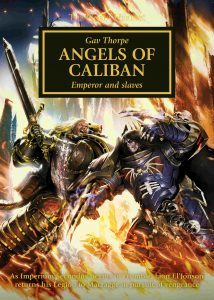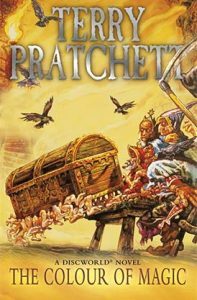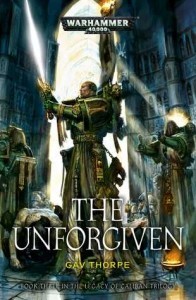Self-contained Narrative in Series Fiction
One of the truths of modern genre writing is that, more often than not, a novel is going to be part of a series. It may be a trilogy or longer (Gaunt’s Ghosts, anyone?), or part of a shared narrative like the Horus Heresy. Fans like to get involved in the long-burn stories that a good doorstep trilogy provides – just look at the success of A Song of Ice and Fire or Wheel of Time.
On the downside, writing as part of a series brings with it a particular set of requirements to ensure the maximum enjoyment of readers. Fans expect the story to fit with the rest of the series and to build upon and move forward with the broader arc, but also to provide a unique and self-contained narrative that is enjoyable in its own right.
 With the publication of Angels of Caliban – a story with more than one plot thread to follow – I thought this would be a good moment to share a few thoughts on how to make sure your series novel (or story or novella…) does the best of both.
With the publication of Angels of Caliban – a story with more than one plot thread to follow – I thought this would be a good moment to share a few thoughts on how to make sure your series novel (or story or novella…) does the best of both.
As usual, I’m going to talk about planning, because preparation is vital in identifying exactly what it is that your story needs to do. In essence, you must identify the plot threads that are leading in to the novel, decide on the outcomes of the story you need to continue the series, and then work out the best story to tell between those various points.
And then I’ll write a little bit about how to recap information for the benefit of readers, without overwhelming the flow of the story.
Even though trilogies in particular can suffer from ‘middle book syndrome’ (in which the 2nd book doesn’t really achieve much except to transport characters from the end of book 1 to the start of book 3 like a flabby second act) most of what I am about to write applies equally to first and last books.
Threads In
All stories have events that occur before the first line begins. It’s called backstory. This should not be confused with ‘story’ despite sharing five of the same letters in the same order. Backstory can be revealed or hinted at to provide nuance, revelation and explanation for the main narrative, but it is not directly involved in the plot. That is, the plot begins on page one of the story you are writing. Quite often I start to read a book and realise that I am being presented backstory rather than story. I usually put the book down at this point unless it is very well written.
The same applies to events that have occurred in previous volumes in a series. Not everything is relevant to the story at hand. Characters should retain consistency and develop across the series, but not every moment from every book has to be relevant to the other volumes. Sub-plots exist within a book, rarely across them. If it’s that important, it’s plot, not sub-plot.
(Important note here. There are many long-running series that have endless sub-plots running from volume to volume. In fact they don’t actually have a plot at all. Some people seem to really like reading them. I don’t. I think of it as soap opera, not drama, although if done well it can become character study.)
Despite the mountain of character stories feeding into Angels of Caliban and the Horus Heresy in general, I identified just a handful of relevant threads and themes. These were:
The Lion and Curze’s antagonistic history.
Curze’s actions in Macragge Civitas, in particular with Sanguinius (as seen in Pharos).
The remnants of the Shadow Crusade.
Guilliman’s relationships with his subordinates and his role in Imperium Secundus.
Astelan’s moves to strengthen his ties to Luther and his history with Belath.
Zahariel’s encounters with the Watchers and Ouroboros and his burial beneath Northwilds.
References to Zaramund from the existing lore, and Loken’s recognition of Luther from ‘Grey Angel’.There is, obviously, a lot more going on in the details, but these were the main series threads I knew had to be picked up for the Imperium Secundus and Caliban arcs to move toward towards their respective conclusions.
 Before you begin you need to work out which parts of your characters’ histories are relevant to this story and will be explored further. The one night stand with the barman? Yep, that’d be good for a sub-plot if they meet again. The comical episode with the taxi cab and the umbrella? Not so much.
Before you begin you need to work out which parts of your characters’ histories are relevant to this story and will be explored further. The one night stand with the barman? Yep, that’d be good for a sub-plot if they meet again. The comical episode with the taxi cab and the umbrella? Not so much.
The next nuance is a thorny one, on which I could write a lot more but won’t. I will assume, simply for the sake of this article, that you have an over-arching plot that runs through the series – sometimes called meta-narrative although usually it’s just a normal narrative but a lot longer and more complicated (for a good example of a true meta-narrative see the gradual social and technological development of Ankh Morpork through the Discworld series).
You need to work out the state of the series-long narrative at the start of the novel. Aside from the actual story that starts on page 1 and ends on page X in this particular book, what other plot points feed into this episode in the series? Who has died, for example, and what effects may that have? What characters have arrived? Where are we in encountering and overcoming the narrative conflicts that make up the big picture story?
Outcomes
When you have (to some extent) nailed down the plot points, characters arcs and sub-plots that are going into the story, you need to work out where they will be by the end of it. Will the love affair between Roland and Harry be resolved in this book? Are you going to introduce the nuke under the White House yet?
Even before you start on the story for the book itself – bearing in mind that it isn’t going to be simply a transition from point a to point c – you have to think about where the book fits within the context of the series narrative. Like the individual components, the series has a pacing too. Cram in too much up front and you are left with simple thread-tying at the end. Leave out too much and the last book is going to be crammed full of plot resolution without having a story of its own. Throw everything into the first book and people may be overwhelmed by how much is going on, again to the detriment of the story, obscured by all of the set-up for later narrative.
In this regard I like to apply a simple rule (which can be used in lots of ways like world building and description): introduce ideas no earlier than absolutely necessary. It kinda sounds trite in isolation, but ask yourself if the reader really, really needs to know about character Y or if event X has to happen now to give you time to resolve the conflicts arising from their arrival.
I can’t really go into the outcomes of Angels of Caliban without some massive spoilers, but in summary I knew that I had to achieve the following:
Imperium Secundus morally failed if not physically ended.
The Lion and Curze hunt resolved.
Zahariel learns of Nemiel’s death and his turn against the Imperium.
Luther has rebuilt the Order and has the means to get away from Caliban.
The important thing to remember is that these aren’t sub-plots that could conceivably go unresolved, but the stepping stones of the whole series. There should be some conclusion to the events as they unfold, by the end of the series.
Identify Main Plot
Given that you now have your start points and end points there is now a complicated task ahead. You must weave a narrative between those points that both moves the big story from one to the other but also in itself gives a satisfying completeness to the book. If you fail to deliver enough big plot the book will feel like it’s a sideline, treading water, ‘filler’. If you do too much series story it will lack a satisfying internal structure to guide the reader along the major threads.
There are two ways to deal with these different levels of narrative, and you will probably need a combination of both. Firstly, big plot arcs can be connected through sub-plots in the contained narrative. That is, events can trigger and resolve the major threads as a break from the main plot of this volume. Too much of this style and it may feel like one of those video game RPGs in which you are literally in the middle of an important quest to save the world from dragons but get distracted having to help out a little old lady who needs someone to escort her grandson through bandit country to the next town…
 Secondly, you can have the series plot and the book plot intersect. This means that an arising conflict or resolution point for the book’s plot also brings forth a move in the big plot. If done well this can even add more conflict – resolving the book plot creates conflicts for the series plot and vice versa. Remember, never give your characters an easy ride. If they take the boy, the dragon trashes another city. If they leave the boy, the bandits get him. Which is a shame, because he was actually Prince Numtetumtum in disguise! Shock! Horror! Plot!
Secondly, you can have the series plot and the book plot intersect. This means that an arising conflict or resolution point for the book’s plot also brings forth a move in the big plot. If done well this can even add more conflict – resolving the book plot creates conflicts for the series plot and vice versa. Remember, never give your characters an easy ride. If they take the boy, the dragon trashes another city. If they leave the boy, the bandits get him. Which is a shame, because he was actually Prince Numtetumtum in disguise! Shock! Horror! Plot!
A combination of sub-plot and overlapping plot will do nicely, to stop events in the book becoming too coincidental, as if the characters are on rails toward the series conclusion, but pushing forward the story in a paced and timely fashion.
All of which means that the story – conflicts, encounters and resolutions – of this particular book needs to exist without recourse to the rest of the series. Having devised a cunning way in which the story moves everything along, look back at your plan and remove everything that references any plot that occurs before or after this volume. Is there enough story left that if you were to release this as a standalone book (albeit with fewer pages) it would still be considered a decent tale? Conversely, when you look at the big series elements you would remove, is there enough there to make readers feel the book is an essential part of the ongoing story? Not just in terms of sub-plot, world building and character development, but major advances or setbacks that are game-changers for the characters and world.
Lastly, I’d like to address the issue of how to bring the reader up to speed if they pick-up a series late or if they may have forgotten some points from the previous volume(s).
One way is with a straightforward opening section that sets out what has happened so far. The Unforgiven has such a ‘Previously on…’ section, written at the request of the editors. It works for TV series, don’t be coy. If there isn’t a subtle way of getting folks on track, be obvious instead.
Usually we would want to avoid that, in which case we return to the mindset of treating previous volumes as backstory. Only refer to what is relevant when it needs referring to and not again for the sake of completeness. Try to use the narrative voice to go over old ground, unless you have a new character introduced in which case some exposition won’t feel as forced.
From Angels of Caliban:
“Five Hundred Worlds. Lost among them was the Lion’s prey. Konrad Curze, the Night Haunter, another of his demigod brothers. A madman in a superhuman body. A present danger to everything that they hoped to achieve with Imperium Secundus.
More than that, the matter between Curze and the Lion had become personal the moment the Night Haunter had tried to kill him at Tsagualsa. The shame of losing the Primarch on Macragge still gnawed at the Lion. Death and anarchy had followed. Humbled before his brothers, shown up for his weakness.
Somewhere in the Five Hundred Worlds, Curze hid. The Lion would find him. He had grown up hunting down the worst beasts Caliban had harboured, with nothing more than his guile and strength. This was no different.
This time he would not let the Night Haunter escape.”
Though I get in tangles with my editors about it on occasion – one in particular – there’s also nothing wrong with the occasional flashback from a previous book (or possibly even someone else’s book, but that’s where the tangles arise). This is especially true if new events change the context of the scene to which you are returning. If you want the reader to remember exactly how Dangarion lost his eye, have him recall it at a pertinent moment in some detail – and make the recollection relevant to the plot or a sub-plot. Does it put him off-guard? Change his mood? Steer him down a certain choice towards a bad consequence?
From Angels of Caliban:
“I will be transmitting my orders before daybreak,” the Lion said, looking directly at Guilliman. “Now is the time to voice any objections. We must be of one mind on this matter.”
The Lord Warden did not return his gaze, but spent some seconds studying the scaled down city. How different a reaction from the last time the Lion’s warriors had come to Macragge Civitas. Four hundred drop pods had descended toward the fully active defences, certain death for those within. It had been the Lion’s wariness that had prepared the planetstrike, but the actions of Curze to launch it.
Even so, he could not forget that one simply miscalculation had almost ended everything before it had started. Had Guilliman not listened, had allowed thousands of Dark Angels to die in the skies above Macragge Civitas, the shaky trust that existed between them would have faltered in seconds. Put simply, Imperium Secundus would have died on that day along with many sons of Caliban and Macragge.”
Presented in such a way, at the correct time, the recap gains relevance for the reader not just in terms of jogging their memory, but also making it clear why that previous event is now having direct consequences on the book plot and / or the series story.
Though I have talked in terms of novels for the most part, the same might apply to other episodic tales such as serialisations, novellas and short stories. I hope it has been helpful for those thinking about their second book or maybe embarking on a lengthy series or collection of short stories (and if it has, you may like to look at my other blogs about writing tie-in fiction).
Let me know in the comments what you think, and if you have a different approach to writing series fiction.
I’m going to publish an Angels of Caliban specific Q&A blog in a couple of weeks, after people have had a chance to read the book. If you have any questions, comments or observations, just get in touch. I’ll reply to you directly, and combine all responses into one blog post.
**To make sure you don’t miss out on any blog posts, you can keep up-to-date with everything Gav by signing up to my monthly newsletter. As a bonus, every other month I randomly pick a newsletter subscriber to receive a free signed copy of one of my books.**
 newest »
newest »
 I always promise myself a better plan before starting the next project. Although that better plan never seems quite good enough!
I always promise myself a better plan before starting the next project. Although that better plan never seems quite good enough!




